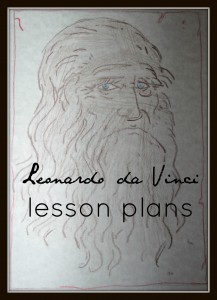 One of the most fascinating men of all times is Leonardo da Vinci. His achievements in both the art and scientific worlds are astounding . We took 8 weeks to delve into his biography, and I can assure you that my children would have been happy if I had allowed them another 8 weeks to continue their explorations.
One of the most fascinating men of all times is Leonardo da Vinci. His achievements in both the art and scientific worlds are astounding . We took 8 weeks to delve into his biography, and I can assure you that my children would have been happy if I had allowed them another 8 weeks to continue their explorations.
Here is what we did – feel free to borrow anything you find helpful, I simply ask that you make sure to link back and credit appropriately if you decide to share.
Spine:
“Leonardo da Vinci” by Kathleen Krull (chapter 4 may be skipped if you wish to avoid discussion of Leonardo’s romantic relationships).
Craft Instructions (supply list provided at end):
~ Amazing Leonardo da Vinci Inventions you can Build Yourself by Maxine Anderson
~ Leonardo da Vinci for Kids by Janis Herbert
Notebook resources:
NEST learning system activity pages {no longer available. Sorry!}
Dynamic2Moms lapbook elements
Favorite supplemental resource:
~ “Journal of Inventions” paper-art book designed to look like Leonardo’s notebooks providing an insight into his notes and inventions.
~ Additional resources listed at the end of the lesson plans.
Leonardo da Vinci, The Great Observer
Leonardo da Vinci is well known as a “Renaissance Man,” knowledgable in a wide range of fields. His formal schooling was minimal, but he spent his entire life learning about the world and recording his observations. His areas of expertise include engineering, painting, architecture, anatomy.
- Learn about Leonardo’s early childhood
- Discuss the term “renaissance man”
- Make wearable observation notebooks and collection pouches
- practice mirror writing
- Read aloud the introduction & chapters 1 & 2 of Leonardo da Vinci (Giants of Science) by Kathleen Krull
- try mirror writing at: http://legacy.mos.org/sln/Leonardo/write.html
- turn the pages of Leonardo’s notebooks at: http://www.bl.uk/onlinegallery/ttp/ttpbooks.html
Leonardo da Vinci, Apprentice
Leonardo da Vinci apprenticed with the famous artist Andrea del Verrocchio in Florence, the cultural center of Europe. He took delight in learning about every-day subjects like water, an especially important commodity in his world.
- Discuss Leonardo’s fascination with observing the natural world and focus specifically on water
- Make your own webbed swim fins
- Read chapter 3 and 4 of Leonardo da Vinci (Giants of Science) by Kathleen Krull
- note: you may want to pre-read chapter 4 to determine if you want to cover Leonardo’s personal relationships in with your child.
- Read Journal of Inventions: Leonardo da Vinci by Jaspre Bark – pages marked “Hydraulics”
- Read In Renaissance Florence with Leonardo by Renzo Rossi
- Try to guess what Leonardo’s inventions do at http://legacy.mos.org/sln/Leonardo/LeosMysteriousMachinery.html
Leonardo da Vinci, Weapons of War
Leonardo was known for being negligent of his obligations. He was fascinated with technical process of designing projects, yet rarely followed through with his promises. He left behind a total of only 13 finished works yet we have over 13,000 pages of his sketches. In that time people who could design weapons were highly employable, so many of these sketches reflect that interest. Eventually Leonardo left Florence and moved to Milan where Duke Sforza became his patron.
- Learn about Leonardo’s personal distaste for war, and the economic demand for his inventions
- Make your own tank based on Leonardo’s design
- Read chapter 5 of Leonardo da Vinci (Giants of Science) by Kathleen Krull
- Look at Journal of Inventions: Leonardo da Vinci by Jaspre Bark – pages marked “War Machines”
- Watch a replica of Leonardo da Vinci’s tank in action: http://dsc.discovery.com/tv-shows/other-shows/videos/doing-davinci-tank-test.htm
- Read Leonardo’s job resume: http://www.adifferentplace.org/Leonardo%20da%20Vinci%20Job%20Resume.pdf
- Watch two groups designing and testing trebuchets based on historic designs in Nova’s video: MedievalSiege
Leonardo da Vinci, Painting & Sculpture
Leonardo da Vinci’s artwork was not limited to paintings. He created great sculptures as well. Artists at that time had to learn not only painting, but also how to make practical and useful items such as costumes.
- Read Jean Fritz’s Leonardo’s Horse Copyright 2001, G.P. Putnam’s Son, Fogelsville, Pennsylvania.
- Built your own clay horse using found objects as a “skeleton”
- Catch up week – complete any unfinished reading or projects from the past few weeks, and begin researching catapult and trebuchet designs for the last class.
Leonardo da Vinci, Architecture
Leonardo da Vinci began his architectural studies by looking closely at tools. He then progressed to creating his own designs, filling his notebooks with plans for canals, stables, and churches.
He was fascinated with severe weather, and his architectural drawings reflect this as he examined the strength of pillars, arches, and beams. He even presented a plan for the “ideal city” which would provide a healthier environment, but because his plans would require the complete rebuilding of Milan, his ideas were never implemented.
- Discuss architectural style, the problems Leonardo was concerned about (cracks, foundations, etc.) and his ideas for solutions.
- Learn about Leonardo’s connection with the plague and his design for the ideal city
- Make your own measuring wheels based on Leonardo’s ideas
- Read chapter 6 of Leonardo da Vinci (Giants of Science) by Kathleen Krull
- Read Journal of Inventions: Leonardo da Vinci by Jaspre Bark – pages marked “Architecture”
- View the modern day version of Leonardo’s bridge: http://news.bbc.co.uk/2/hi/europe/1630792.stm
___
Leonardo da Vinci, Flight
From a young age Leonardo da Vinci was captivated by the idea of air travel. He spent a lot of time studying nature and used his knowledge to design a multitude of mechanical devices with the goal of human flight. It is not known if he ever tested these, but he is hailed as one of the pioneers of aviation, despite living 400 years before the first successful manned flight.
- Learn about Leonardo’s fascination with flight
- Build your own Air-screw and launcher (note: We had a hard time getting these to work. As frustrating as that seems, it gave us a wonderful opportunity to discuss Leonardo’s untested plans, and understand the necessity of persistence in innovation.)
- Read chapter 7 of Leonardo da Vinci (Giants of Science) by Kathleen Krull
- Read Journal of Inventions: Leonardo da Vinci by Jaspre Bark – pages marked “Flying Machines”
- Take a look at these great Leonardo science experiments! http://www.mdsci.org/pdf/Exhibits/Da%20Vinci%20Activities%20Guide%202009.pdf
Leonardo da Vinci, The Human Body
Leonardo da Vinci believed that in order to accurately represent the human body, one had to understand it. He dissected many corpses during the course of his life, and learned much about anatomy. Among other things, he discovered arteriosclerosis by comparing the arteries of a very old man to those of a child.
- Examine Leonardo’s close attention to the details of size and scale by coloring copies of his “Proportions of the Human Figure”
- Make your own perspectograph
- Make a graph of class measurements to determine is Da Vinci’s Vitruvian man predictions were correct.
- Read chapter 8 of Leonardo da Vinci (Giants of Science) by Kathleen Krull
- Read Journal of Inventions: Leonardo da Vinci by Jaspre Bark – pages marked “Mechanical Man” (Note: There is a picture of the Vitruvian man under the right-hand flap. You may want to pre-view it to determine your own comfort level with this image.)
- View an extensive collection of Leonardo’s anatomy drawings at: http://www.royalcollection.org.uk/exhibitions/leonardo-da-vinci-anatomist (reminder – some of these are very accurate. Please pre-view)
Leonardo da Vinci, Mechanics
Ready Set Launch! I hope your family had a fabulous time studying this Renaissance man. Leonardo da Vinci is a great inspiration for trying new things.
- Discuss the changes that Leonardo inspired
- Watch The Animated Hero Classics: DaVinci by Nest Complete Learning System (30 min) http://www.youtube.com/watch?v=sNlGKUWacQY
- Finish reading Leonardo da Vinci (Giants of Science) by Kathleen Krull
- Journal of Inventions: Leonardo da Vinci by Jaspre Bark – pages marked “Mechanical Inventions”
- Build your own trebuchet! Here are a few ideas to get you started –
Create your own:
Lego catapult: http://kidsactivitiesblog.com/lego-catapult/
Paper catapult: http://www.mikesenese.com/DOIT/2011/10/palm-sized-print-and-cut-paper-trebuchet/
More catapult designs: http://www.instructables.com/tag/type-id/?q=catapult&sort=none
Trebuchet designs: http://www.instructables.com/tag/type-id/?q=trebuchet&sort=none
Buy a kit:
Amazon has many ready to assemble kits – including this one inspired by Leonardo da Vinci
Additional Resources
If your student is excited to learn more about the life and inventions of Leonardo da Vinci, take a look through these fun resources.
(Again, please remember to preview any books or websites you choose for your student. Leonardo da Vinci was accused of an inappropriate relationship during his youth. The charges were dropped, but some books and websites go into detail about the incident. Also, Leonardo studied human anatomy extensively, and that interest is reflected in his work.)
Books (with my favorites listed at the top):
Leonardo: Beautiful Dreamer by Roberty Byrd
Monday with a Mad Genius (Magic Tree House series) by Mary Pope Osborne, and the accompanying Fact Tracker, Leonardo da Vinci
Leonardo da Vinci by Diane Stanley
Who was Leonardo da Vinci by Roberta Edwards
Leonardo da Vinci by Barbara Witteman
The Inventions of Leonardo da Vinci by Margaret Cooper
Leonardo da Vinci: Renaissance Painter by Brendan January
Audio:
Masters of the Renaissance narrated by Jim Weiss
Activity Kit:
Treasure Chests: Leonardo da Vinci and the Renaissance by Andrew Langley
Web:
Boston Museum of Science – Da Vinci: Scientist, Inventor, Artist: http://www.mos.org/leonardo/
Leonardo, The Man, His Machines: http://www.lairweb.org.nz/leonardo/index.html#stages
Leonardo da Vinci National Science and Technology Museum www.museoscienza.org/english/leonardo
Leonardo da Vinci biographical video: http://www.biography.com/people/leonardo-da-vinci-40396/videos/leonardo-da-vinci-full-episode-2073405212
Craft Supply List
Observation Notebook
- index cards
- 1 inch binder rings
- printed cards for cover
- hole punch
- short pencils
Collection Pouch
- brown felt
- large needles
- scissors
- beige embroidery floss
- thick string
Swim fins
- latex gloves
- skewers
- duct tape
- scissors
- permanent marker
Armored tank
- disposable pie pans (2 per student)
- kitchen size match boxes
- scissors
- 1/4” dowels
- duct tape
- glue
Measuring Wheel
- cardboard
- paint sticks
- thumb tacks
Air Screw
- Cereal boxes
- Scissors
- compass
- pencil
- 3/8” dowel
- hammers & nails
- vegetable garden stakes
- string
- duct tape
Perspectograph
- empty cd case
- dry erase marker
- heavy cardboard
- tracing paper
- hole punch
Clay Horse
- clay
- recycled items (wire, paper tubes, etc.)





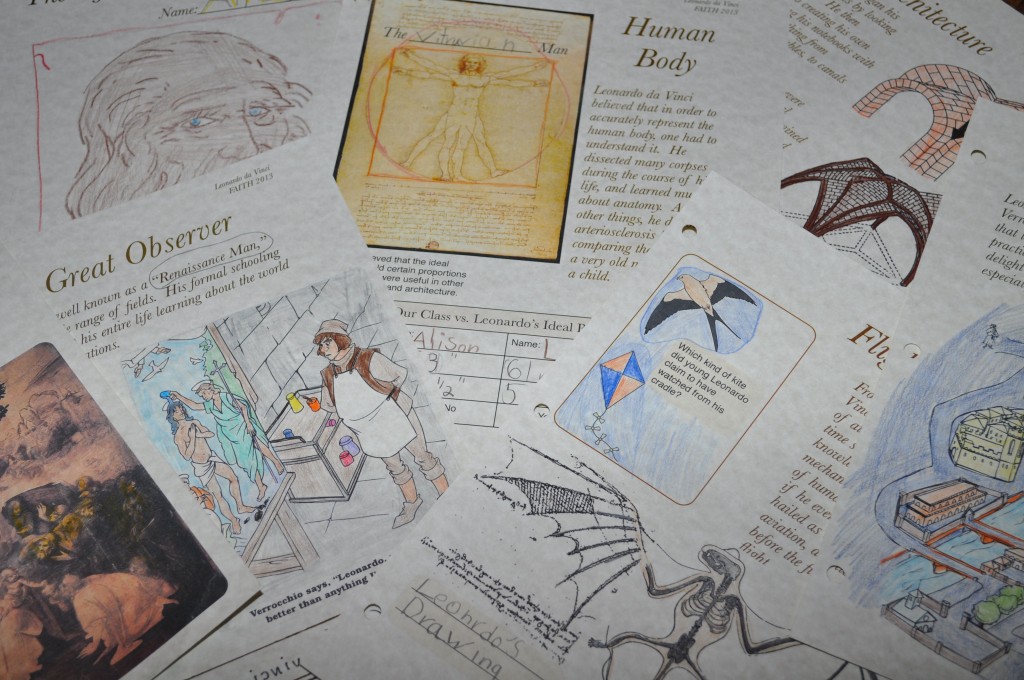

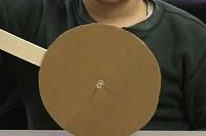
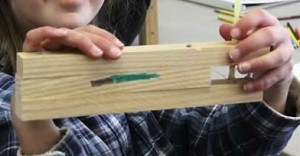
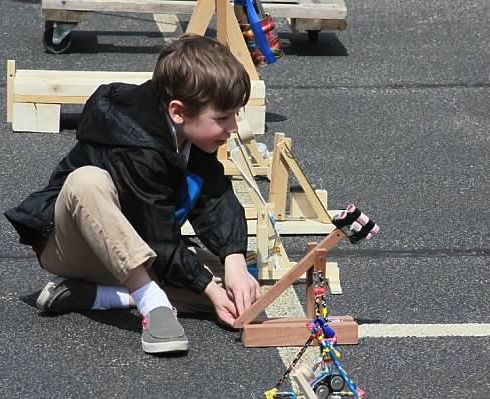
This is wonderful! Pinning it for future use!
Pingback: Leonardo Da Vinci Resources (ICT-related)
Great resources. Take a look!
Pingback: Leonardo da Vinci Graphite Lesson for kids - Liberty Hill House
It seems the notebook pages on the site you linked are no longer available. Do you have those pages saved and can you share them with me via email? They sure do look good!
Oh, I’m sorry the link is broken. I don’t have the Nest pages saved, sorry!
Pingback: The Legendary Leonardo | Toomanyflower's Travels
Pingback: 100+ Homeschooling Lessons and Printables - ABC Creative Learning
Not sure if this is the same resource, but Dynamic2Moms moved their stuff. The one Mom still has a blog and it has Leonardo Da Vinci stuff on her Rennaisance lapbook page:
http://www.tinasdynamichomeschoolplus.com/middle-ages-to-reform/renaissance/